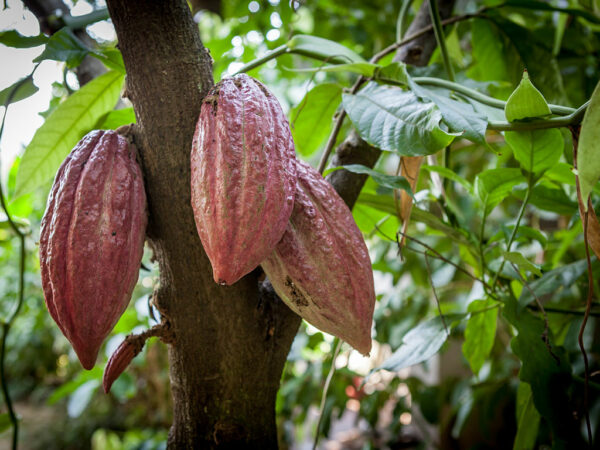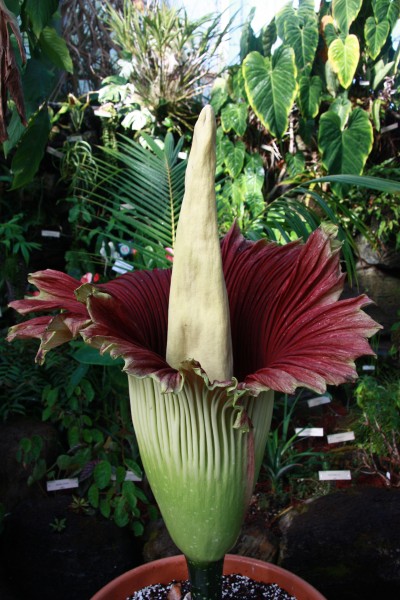The Tropical House
Closed until further notice for interior redesign
Tropical House Renovations
 For nearly 50 years, the Garden’s Tropical House has been a source of wonder and delight for visitors, young and old. For many, the Tropical House was their first (and perhaps only) glimpse of a tropical environment. The towering plants, moist air, and earthy aromas evoked a mysterious world and provided a unique educational experience. Here, children learned that chocolate does grow on trees. Gathered around the cacoa tree, docents awed school children with nibbles of bitter cocoa pods and sweetened chocolate chips, providing a hands-on lesson connecting plants and food. Here, we were amazed by the magnificent exotic titan arum (Amorphophallus titanum).
For nearly 50 years, the Garden’s Tropical House has been a source of wonder and delight for visitors, young and old. For many, the Tropical House was their first (and perhaps only) glimpse of a tropical environment. The towering plants, moist air, and earthy aromas evoked a mysterious world and provided a unique educational experience. Here, children learned that chocolate does grow on trees. Gathered around the cacoa tree, docents awed school children with nibbles of bitter cocoa pods and sweetened chocolate chips, providing a hands-on lesson connecting plants and food. Here, we were amazed by the magnificent exotic titan arum (Amorphophallus titanum).
Closed since 2021 when the exterior was reskinned, the Garden received approval from UC Berkeley last year to begin the interior construction. J. R. Griffin Construction (who also conducted the reskinning project) was chosen to complete this work.
Plans by renowned landscape architect Ron Lutsko are guiding this vibrant, exciting interior and entrance plaza creation that will nearly double the space for education and plant display. The Tropical House will comply with all ADA requirements, and the tropical experience will be enhanced with the addition of a pond, bridge, a fountain and a living wall of plants.
The Tropical House Collection

The Garden’s Tropical House provides vital housing for collection specimens (large and small) that require a warm, humid environment to thrive. The plant palette has shifted over time to better accommodate campus teaching needs and the Garden’s interpretation of the wet tropics.
The strongest interpretive and planting theme is ethnobotany. Plants important in human uses (food, fiber, medicine, etc.) continue to be featured. These are arranged by geographic origin, formerly referred to as Old World (Asian/Australasian) and New World (Western Hemisphere), consistent with the general geographic arrangement of the outdoor collections. As we embark on a redesign of the interior, we reflect on this ethnobotanical theme’s variations as it was installed and renovated several times before. Several plants are especially popular, including cacao (chocolate), vanilla, coffee, and pepper. We interpret their usefulness to people while also describing their context in nature.
For example, since 2002, we have learned that the cacao tree (Theobroma cacao) is native only to South America and was distributed by people to Central America and Mexico. Today it is cultivated wherever conditions are favorable near the equator. 70% of the world’s cocoa production is from West African countries. The environmental impacts of farming cacao trees can be mediated by not clearing native tree species, to provide the shade needed by the cacao trees. Compared to traditional orchards, this cultivation technique can reduce the loss of plant and animal biodiversity within the modified plantation. Also, cacao trees need a certain amount of humidity and ground cover plants to support the midges that pollinate their flowers. The midges are also food for birds. The ground cover plant layer hosts other invertebrates, and the canopy hosts animals, epiphytes, and more. We tell this story of growing cacao trees by best practices under a native plant shade canopy to support biodiversity.
In addition to plants with ethnobotanical uses, the Tropical House can support our educational efforts to display and interpret tropical biodiversity hotspots of the world and their conservation issues, now in the context of climate change. This interpretive theme includes iconic plants that may come to mind when thinking about wet tropical locales, like palm trees, lianas, epiphytes, and orchids, some of which are endangered. This assemblage serves our mission of supporting education, research, and conservation.
The contrasting environment of the Tropical House with the rest of the outdoor collections makes it one of our most popular destinations. We look forward to a redesigned interior that will make the most of the limited space to provide an immersive tropical forest experience of heat, humidity, and lush foliage.
Titan Arum

One of the most famous plants in this collection is the titan arum (Amorphophallus titanum). This plant is native to the rainforests of Sumatra, Indonesia. They produce one of the world’s largest flowering structures to lure insects with the illusion of decay—having both the appearance and odor of rotting flesh; hence the plant’s common name, “corpse flower.”
Titan arums produce only one leaf at a time, but they’re one of the world’s largest leaves. A young titan arum produces a relatively small leaf, but each leaf it produces is bigger than the previous leaf, eventually reaching 3 to 5 meters (10–15 ft) tall—as large as a small tree! The leaf photosynthesizes, making sugars that are stored as starch in a swollen, underground stem (corm). The corm must reach at least 14 kg (30 pounds) before blooming may occur; corms have been known to weigh up to 90 kg (200 pounds). A leaf withers after about 16 months and the titan arum goes completely dormant for four months or longer. When it next sprouts, the corm will produce either another single leaf or a bloom. Because flowering takes so much energy, the corm produces one leaf after another for years before blooming again. It’s typically 6–7 years before a titan arum blooms for the first time, but it may take much longer. The flowering structure may take months to form, but only remains open for a day or two while pollination may occur. Without pollination, the whole structure collapses and the cycle repeats.
A titan arum bloom appears to be the world’s largest flower, but it is actually a stalk of many flowers (an inflorescence). Hundreds of tiny, petal-less flowers are clustered at the base of the yellowish-gray, phallus-like structure (spadix) that can grow to be over 3 meters (9 ft) tall. The flowers are hidden from view by a large, pleated, skirt-like covering (spathe) that is light-green and speckled cream on the outside and deep maroon on the inside. If pollination takes place, the spadix remains firm while the fruits develop over a period of months.

